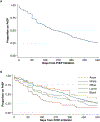Racial/ethnic and HIV risk category disparities in preexposure prophylaxis discontinuation among patients in publicly funded primary care clinics
- PMID: 31436610
- PMCID: PMC6832847
- DOI: 10.1097/QAD.0000000000002347
Racial/ethnic and HIV risk category disparities in preexposure prophylaxis discontinuation among patients in publicly funded primary care clinics
Abstract
Objective: Dissemination of preexposure prophylaxis (PrEP) is a priority for reducing new HIV infections, especially among vulnerable populations. However, there are limited data available on PrEP discontinuation following initiation, an important component of the PrEP cascade.
Design: Patients receiving PrEP within the San Francisco Department of Public Health Primary Care Clinics (SFPCC) are included in a PrEP registry if they received a PrEP prescription, were not receiving postexposure prophylaxis, and not known to be HIV-positive.
Methods: We calculated PrEP discontinuation for patients initiating PrEP at any time from January 2012 to July 2017 and evaluated their association with demographic and risk variables using Cox regression analysis.
Results: Overall, 348 patients received PrEP over the evaluation period. The majority (84%) were men, and the cohort was racially/ethnically diverse. The median duration of PrEP use was 8.3 months. In adjusted analysis, PrEP discontinuation was lower among older patients (aHR 0.89; 95% CI 0.80-0.99; P = 0.03); but higher among black patients (compared with white patients; aHR 1.87; 95% CI 1.27-2.74; P = 0.001), patients who inject drugs (aHR 4.80; 95% CI 2.66-8.67; P < 0.001), and transgender women who have sex with men (compared with MSM; aHR 1.94; 95% CI 1.36-2.77; P < 0.001).
Conclusion: Age, racial/ethnic, and risk category disparities in PrEP discontinuation were identified among patients in a public health-funded primary care setting. Further efforts are needed to understand and address PrEP discontinuation among priority populations to maximize the preventive impact of PrEP, and reverse HIV-related disparities at a population level.
Figures
Similar articles
-
HIV risk perception and PrEP uptake among black MSM in Mississippi.Int J STD AIDS. 2025 Feb;36(2):119-125. doi: 10.1177/09564624241297830. Epub 2024 Nov 5. Int J STD AIDS. 2025. PMID: 39499863
-
Missed opportunities to prevent HIV infections among pre-exposure prophylaxis users: a population-based mixed methods study, San Francisco, United States.J Int AIDS Soc. 2020 Apr;23(4):e25472. doi: 10.1002/jia2.25472. J Int AIDS Soc. 2020. PMID: 32294338 Free PMC article.
-
Inequities in HIV prevention among trans and/or non-binary people: a cross-sectional survey analysis of PrEP and PEP awareness and use in Spain.Int J Equity Health. 2025 Jul 7;24(1):197. doi: 10.1186/s12939-025-02574-4. Int J Equity Health. 2025. PMID: 40624632 Free PMC article.
-
Behavioral interventions to reduce risk for sexual transmission of HIV among men who have sex with men.Cochrane Database Syst Rev. 2008 Jul 16;(3):CD001230. doi: 10.1002/14651858.CD001230.pub2. Cochrane Database Syst Rev. 2008. PMID: 18646068
-
Awareness and willingness to use HIV pre-exposure prophylaxis among men who have sex with men in low- and middle-income countries: a systematic review and meta-analysis.J Int AIDS Soc. 2017 Jun 26;20(1):21580. doi: 10.7448/IAS.20.1.21580. J Int AIDS Soc. 2017. PMID: 28691439 Free PMC article.
Cited by
-
PrEP Among Sub-Saharan African Diaspora Communities in Belgium - a Participatory Action Research Study.J Community Health. 2024 Feb;49(1):156-165. doi: 10.1007/s10900-023-01269-7. Epub 2023 Aug 14. J Community Health. 2024. PMID: 37580443 Free PMC article.
-
Pre-exposure Prophylaxis Persistence Is a Critical Issue in PrEP Implementation.Clin Infect Dis. 2020 Jul 27;71(3):583-585. doi: 10.1093/cid/ciz896. Clin Infect Dis. 2020. PMID: 31509603 Free PMC article. No abstract available.
-
The Long-Acting Cabotegravir Tail as an Implementation Challenge: Planning for Safe Discontinuation.AIDS Behav. 2023 Jan;27(1):4-9. doi: 10.1007/s10461-022-03816-0. Epub 2022 Sep 3. AIDS Behav. 2023. PMID: 36056997 Free PMC article.
-
Expanding the Pie-Differentiated PrEP Delivery Models to Improve PrEP Uptake in the San Francisco Bay Area.J Acquir Immune Defic Syndr. 2021 Dec 15;88(S1):S39-S48. doi: 10.1097/QAI.0000000000002809. J Acquir Immune Defic Syndr. 2021. PMID: 34757991 Free PMC article.
-
Insurance- and medical provider-related barriers and facilitators to staying on PrEP: results from a qualitative study.Transl Behav Med. 2021 Mar 16;11(2):573-581. doi: 10.1093/tbm/ibz191. Transl Behav Med. 2021. PMID: 32065637 Free PMC article.
References
-
- Molina JM, Charreau I, Spire B, Cotte L, Chas J, Capitant C, et al. Efficacy, safety, and effect on sexual behaviour of on-demand pre-exposure prophylaxis for HIV in men who have sex with men: an observational cohort study. Lancet HIV 2017; 4(9):e402–e410. - PubMed


